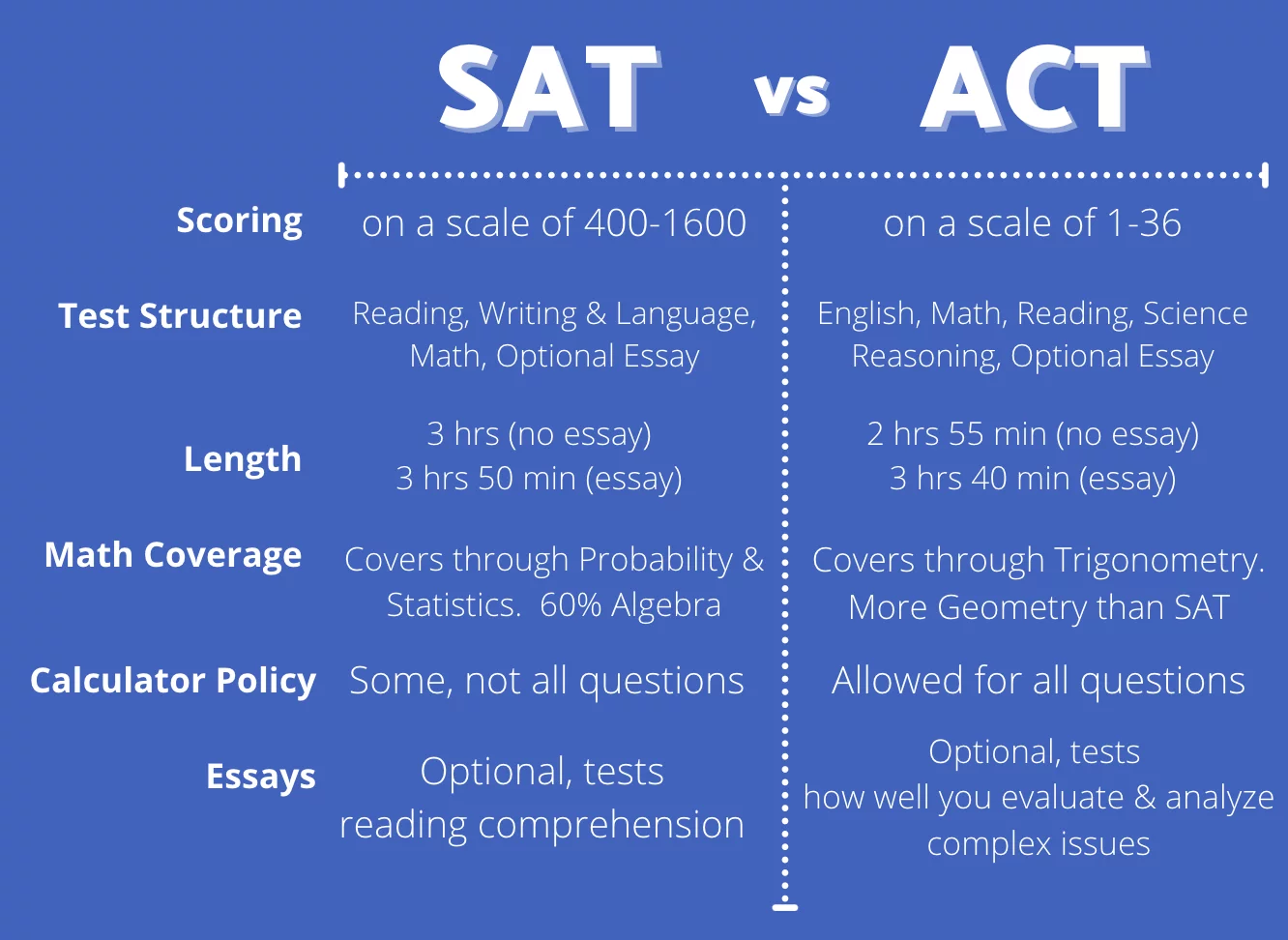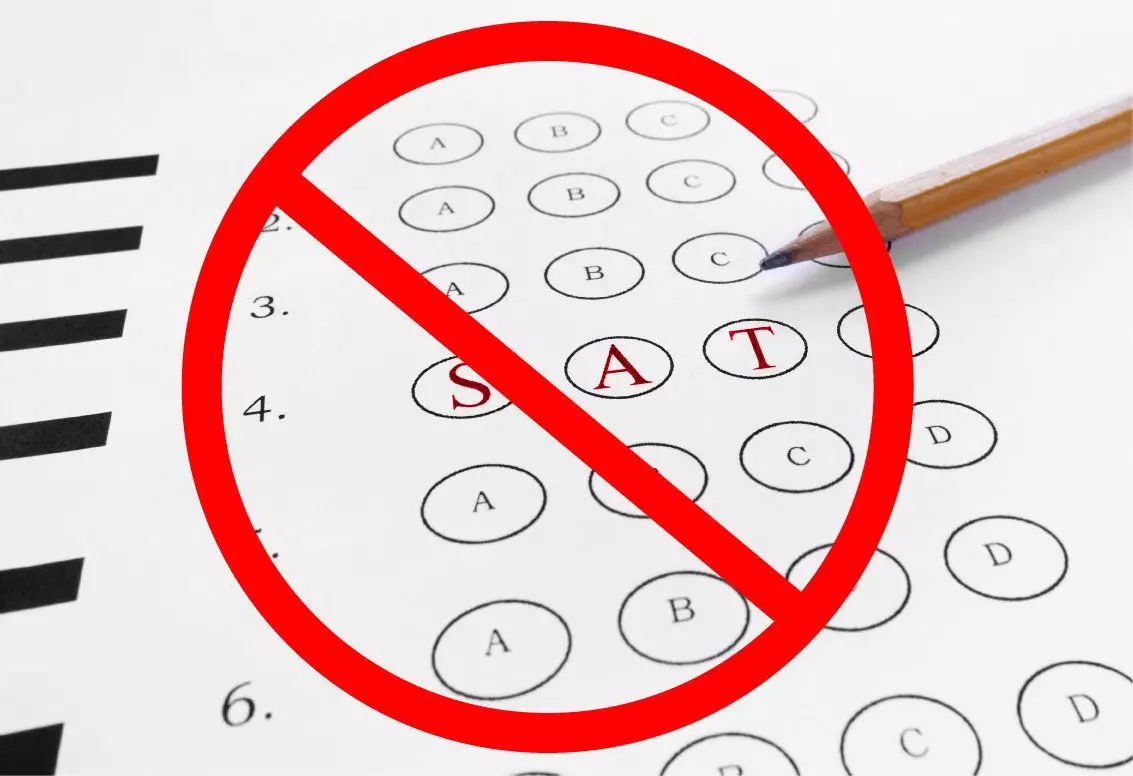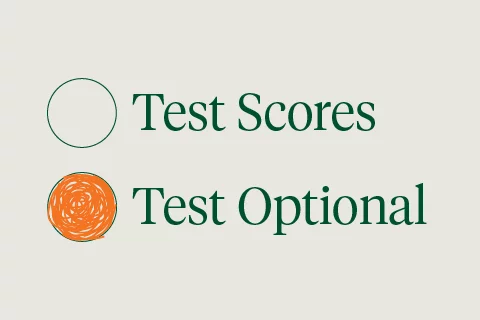When choosing to attend college, many students elect to take standardized exams to supplement their application materials.
Some schools require these tests, while others do not. There are two main tests for students applying for undergraduate studies—the SAT and ACT. While these tests measure similar aptitudes, they are different.
In this guest post, Kevin Organiciak, Founder and Chief Learning Officer over at TPAPT (The Association of Test Prep, Admissions, & Private Tutoring), dives into the SAT vs ACT and how to choose which standardized test is the right option for you.
First things first - let's go through the basics of both tests through this T-chart so you can get an idea of what each one has to offer:

The SAT is the most popular college entrance examination. This test measures student success in reading, writing and language, math, and essay skills. Contrary to what some believe, it is no better or worse than any other college entrance exam or requirement.
It is important to note that while some parts of the SAT allow students to use a calculator on the Math section, others do not. If you want to sharpen your math skills and get comfortable solving problems without a calculator, try it out with an AI-powered math tutor app. These apps can provide step-by-step explanations, adaptive learning paths, and instant feedback to help you master SAT math concepts.
The ACT is the other major standardized college entrance exam. While many students take the test each year, it is slightly less popular than the SAT.
As you can see from the T-chart above, the core subjects for the SAT and ACT are nearly the same, except the ACT also has a science reasoning section.
Overall, the ACT is slightly shorter. This test also allows you to use a calculator, but this time you can use it on all math sections. In terms of the scoring breakdown among the sections, each of the four sections is worth 25% of your final score, making them of equal weights.
Prior to 2016, any guesses made on the SAT were subject to be penalized if you guessed the wrong answer. However, it is important to note that now, there is no guessing penalty for either test, so once you narrow down those answer choices to as few as possible, guess away!
Colleges and universities that require entrance examinations do not have any preference to which test students take or submit.
You could theoretically take both tests, but that is an unnecessary undertaking.
Neither test is easier than its counterpart, so at the end of the day, you should settle on focusing your preparation efforts on the standardized test that you feel you will most excel at, given the parameters and constraints of each.

The first thing you should think about when deciding if you should pursue studying for the SAT or the ACT is which test will highlight your strengths more.
For students who are strong in Science and English subjects, the ACT might be more up your alley. However, if you're a student who struggles in science reasoning but you are strong in math, opting for the SAT may be a better choice.
Next, it's certainly helpful to consider factors other than academic strengths, such as your personal testing style, and the innate advantages and disadvantages of each test.
For example, if you're a whiz at answering a lot of questions in a short amount of time, consider the ACT instead of the SAT, because it is tighter on its constraints in terms of time per question.
Ultimately, the best way to actually go about deciding which test is best for you is to try out both by taking full-length practice tests and comparing your scores and percentiles.
The cost of taking the SAT and the ACT is essentially the same.
The SAT is $49.50 for Writing/ Reading/Math, and adding the essay portion drives the test up to $64.50.
Comparatively, the ACT costs $52 without the essay and $68 with the essay.
Luckily, for students with financial need, it is possible to obtain fee waivers for both the SAT and ACT. Eligibility requirements do vary, so check out these resources (SAT fee waiver info and ACT fee waiver info) to learn more about if you qualify and how to proceed.
Ultimately, the ACT and SAT are similar tests as far as costs, guessing penalties, and nationwide acceptance at colleges and universities.
Because the vast majority of colleges do not prefer one test over the other, you should only prepare for and take the test that you feel best plays to your strengths.
It’s no secret that the COVID-19 pandemic has turned nearly every aspect of our lives upside down, on top of truly (and literally) giving us a run for our money. One specific area which has been particularly impacted by the pandemic is the world of higher education, and even more specifically, the college admissions process.
As any students (and parents) reading this will know, the college admissions process is made up of several key components: GPA, personal statements and supplemental essays, teacher recommendations, and extracurricular involvement, with perhaps the most hotly debated component over recent years, but especially recent months, being standardized test scores.
For the past few decades, students have been told and often reminded of the importance of preparing, sitting for, and succeeding on their standardized tests.
Standardized test scores have proven to be of the utmost importance at the most rigorous and competitive institutions, where test-scores were almost forced to become the primary differentiator between students who proved to be equally high-achieving and promising in the other categories of admission.
Despite this fact, it has become a popular belief (and students have not been wrong to believe it), that test scores are a key factor in the college admissions process.

The raging and flaring pandemic that has been on our hands over the past year has notably wreaked havoc on students’ abilities to successfully register and sit for SAT and ACT exams. In December 2020 alone, nearly 124,000 students were unable to take the SAT due to test center closures, and this number has been steadily ebbing and flowing throughout the entirety of the pandemic.
The fact that many testing appointments have been interrupted, and locations have been essentially shut down due to COVID, has certainly impacted high school seniors who are currently applying for college. In addition to this, it has also had a significant impact on younger high school students who are trying to figure out their admissions strategies and if they should even be preparing to sit for the exams at all.
So, with hundreds of thousands of students nationwide being shut out from taking these exams that, for so long, have been considered a vital component of the college admissions process, what is the proposed solution?
In order to combat the complications that the pandemic has brought upon students and their families as it relates to standardized tests, 1,685 accredited four-year colleges and universities to date have implemented some form of test-optional policy for incoming students.

The term “test-optional” refers to colleges and universities across the U.S. allowing students in upcoming admissions cycles to forgo submitting standardized test scores as a part of their college applications.
The majority of schools have gone test-optional, meaning that students fully have the option to decide whether or not they want to submit standardized test scores. This is the solution that many schools have settled on to tackle the issue of students not being able to successfully sit for the exams when they intended to.
Other variations of the test-optional policy structure include “test-blind” and “test-flexible”.
The test-blind policy, which is currently only being implemented by approximately 65 schools, does not allow any students to submit standardized test scores (and they will not be considered if submitted), regardless of whether or not students were actually able to sit for the exams.
The test-flexible policy allows students to submit alternative standardized test scores (such as AP or IP exam scores, and, up until recently, SAT Subject Tests), in lieu of SAT or ACT scores.
At the end of the day, the majority of schools are and have been adopting the traditional test-optional policies, in which students who are unable or choose not to sit for SAT or ACT exams will not have their applications penalized by admissions committees when it comes to making acceptance decisions.
Currently, the majority of those 1,685 schools are undergoing trials for test-optional admissions. Some institutions are indicating that it is only for the year, while others are using this time as an opportunity to launch several years-long trials of test-optional admissions. It is certainly wise to be following in the footsteps of the institutions that have committed to undergoing several years-long trials of the process.
This has been deemed the best way to perform research and collect data to analyze whether or not test-optional admissions is the way of the future, a turn that many people in the higher education space, myself included, see as a viable and more equitable possibility in comparison to the current policies that are in place.

Rob Springall, assistant vice president for Undergraduate Education and executive director of Undergraduate Admissions, says that “Penn State looks at the student’s academic record in high school, with special focus on the academic areas that relate to their intended major. For students who have not declared a major, the admissions team looks at the student’s overall academic performance in high school”.
Springall explained that Penn State has always put less weight on test scores than on other components of the admissions process, such as high school performance.
He is certainly not alone in making this type of claim; dozens of other colleges and universities have been reverting back to a similar statement in an effort to comfort students that applying to college without a test score is okay.
In the (now, likely) event that students do not submit test scores, institutions have been placing emphasis on a holistic admissions process, meaning everything that you do and can submit, such as your school grades/GPA, the rigor of your courses, teacher recommendations, extracurricular involvement, and personal statements will be weighed more heavily.

Despite the fact that the vast majority of colleges and universities have gone test-optional, students and their families across the US have responded with a certain sense of ambivalence in regards to whether or not they can actually believe the claims that students who don’t submit test scores will still be equally considered alongside their peers that are able to.
Multiple headlines and recent news articles have documented this belief among families, noting that many students are still pushing to get one of those coveted seats at an ACT or SAT test center, even as the global pandemic rages on.
Janet Godwin, the CEO of the ACT, has stated that many students are still choosing to go through with trying (or planning) to push through wherever possible because they want to “demonstrate what they can do”.
But the question is, why are students and their families so skeptical of the claims being made by higher education admissions officials in regards to test scores?
The simple answer is that ACT and SAT test scores are currently one of the primary concrete determinants that can be used to assess a student’s ability and likelihood for success at any given institution.
Standardized test scores have been ingrained as being crucial into the minds of students and their families alike for decades, especially for those students who are competing for spots at institutions with single-digit acceptance rates, making it difficult to simply accept that scores are no longer important or necessary.
At the end of the day, admissions officers and teams are trying to push students and families to not just hear, but to truly believe the statement that “optional does, in fact, mean optional”.
NACAC, the National Association for College Admissions Counseling, put out a statement in an attempt to appease students and families alike, saying “The colleges with test-optional policies in place affirm that they will not penalize students for the absence of a standardized test score. Together, we strongly endorse a student-centered, holistic approach to admission that will not disadvantage any student without a test score.”

Penn State University is one of the many accredited schools, and one of the approximately 900 top-ranked universities, that has made the decision to extend test optional policies for the next two years, in order to “alleviate some anxiety” that many students are facing now due to the pandemic.
Under these test optional policies, students applying to PSU through the Fall of 2023 will have the option to choose whether or not they want to submit standardized test scores (SAT or ACT). Since Penn State implemented these test optional policies, they have proven to be fairly popular among incoming freshmen.
Mark Hatch, VP for enrollment at Colorado College, a private and selective liberal arts college located in Colorado Springs, has stated that his team made the decision to go test-optional pre-pandemic in August 2019.
However, this was only after years of conducting research and analyzing the true impact of test scores on the admissions process. Ultimately, they found that test scores had “a marginal benefit in predictability”, and that other factors such as GPA and class rank were sufficient on their own.
In addition to these findings, another primary reason many schools and higher-ed institutions are now (or have been) in favor of eliminating standardized tests is due to factors surrounding equality.
Take Penn State’s statistics for example. As of December 1st, nearly 58% of all PSU applicants for the Summer/Fall 2021 class chose to not submit test scores as a part of their application.
Among that 58%, Penn State has taken careful notice that a solid percentage of those students are either first-generation or coming from underrepresented racial and ethnic groups. This speaks waves about what so many institutions have been getting at for years: the fact that standardized tests favor wealthy students who have the financial resources to prepare and succeed more so than their less well-off peers.

It seems like the COVID-19 pandemic has been an opportunity, and perhaps exactly what higher education institutions needed, in order to start to push away from putting a stressful emphasis on standardized test scores.
Longtime critics of the SAT and ACT have rightfully stated that these exams are a prime example of how the higher education system favors wealthy students who have the resources (think: private tutors, access to books) to adequately prepare for and succeed in the exams.
Steve Syverson, a retired senior admissions official at the University of Washington at Bothell and Lawrence University, believes that "Lots of colleges didn't really even need to require the SAT, as they were already admitting everyone who was admissible, but they didn't want to eliminate it as a requirement because they felt it would devalue them. In a sense, the pandemic -- and the pervasive adoption of temporary test-optional or test-blind policies -- gave them permission to eliminate the requirement. And I believe a large number of institutions will not return to requiring it. So I think there's no going back."

Merit scholarships, also called academic scholarships, are simply scholarships that students are eligible for based on their grades, test scores, class rank, and other components of their application. According to a study by NACAC, approximately 80% of colleges and universities use standardized test scores to determine and distribute national merit scholarships.
Merit scholarships have notably always been determined partially by the standardized test scores that students submit, with school grades being another primary determinant. Once applicants are admitted to a given school, the school is then comparing qualified student A with qualified student B. Without a standardized test score as an objective numerical differentiator, this makes the process of awarding merit scholarships difficult.
Jeff Schiffman, director of admissions at Tulane University, says that in this process of determining merit scholarships, the admissions committee looks for other “tiebreakers” in addition to (or in place of) test scores, such as an outstanding letter of recommendation or extracurricular activity.
For now, it also seems like the safe option to submit test scores if you have had the opportunity to take either exam if you were satisfied with the outcome, especially if you are hoping to earn some sort of merit scholarship from the schools you are applying to.
I believe that the pandemic has brought a unique silver lining to our attention in relation to the role of standardized tests in the college admissions process of the future.
While schools going test-optional is certainly an opportunity to rebalance these wealth inequities that are often (and rightfully, in my opinion) associated with standardized tests, adopting these policies does mean that the topic of how merit aid and scholarships play into testing will have to be reconsidered.
So, where does this leave us? I guess we'll just have to wait and see ¯\_(ツ)_/¯.
Partially due to the widespread impacts of COVID-19, many colleges and universities (over 1,600 across the US, to be specific) are becoming test-optional institutions.
However, the term “test-optional” is quite nuanced.
Therefore, before diving into answering the question “Is Test-Optional Right for Me?”, I will start by going over the proper definition and breakdown.
Then, because there are many things to consider when choosing to apply to test-optional schools, I will provide you with some helpful information to guide you in successfully making that decision.

At its core, the term “test-optional” in relation to a college or university means that that school does not require some or all of its applicants to submit test scores in order to be considered for admission.
This means that scores from standardized tests such as the SAT or ACT are not required. However, other test scores, such as AP exams, would still be needed to verify credits earned.
Because test-optional schools do not factor your SAT or ACT into their decision-making model, they do put more weight on components such as level of rigor with classes taken, extracurricular activities, community service, and personal statements to make their decisions.
One key thing to note about schools that are test-optional is that many of them still use test scores to determine merit aid awards. So, if you are looking to potentially earn scholarships or grants from your school of choice, consider submitting a test score even if the school is test-optional.

It is important to point out the difference between a school that is “test-optional” and a school that is “test-blind”.
The term test-blind means that ACT and SAT scores will not be considered for admissions or merit aid. Test-blind schools will not even look at your scores if you do submit them.
Currently, approximately 65 schools across the US are completely test-blind; notable contributions to this list include the University of California school system.
Students who struggle with standardized test-taking may choose to go the test-optional route when applying to schools.
Maybe you have already taken both tests and decided that your scores were not an accurate reflection of your abilities and potential. If you didn’t do as well on either test as you would have liked, try to think about the alternatives you can offer on your application that may be able to supplement a lack of test scores. Students with artistic skills may also want to showcase those talents if their test scores do not make them stand out among other applicants.
Additionally, the impacts that the COVID-19 pandemic has had on some students' abilities to actually sit for these tests at testing centers is also another major reason why so many schools are now becoming test-optional.
So, if this sounds like you, then we suggest you definitely do some brainstorming and digging into ways that you can look to differentiate yourself from other applicants since you may not be able to submit a test score.
As mentioned above, students who choose to go test-optional can offer schools creative portfolios, including creative writing, drawings, photographs, sculptures, dance routines, or other artistic demonstrations.
Additionally, students may also choose to enroll in advanced classes (AP or IB), take SAT Subject Tests, or submit other educational evidence with their applications that prove they are strong students.
Each school has its own set of rules for who can use which applications and why. Some test-optional schools make submitting test scores optional for all students; other schools, however, have restrictions for who can use that route.
Sometimes schools allow students who choose to forego test scores and take placement tests to replace the standardized test scores in terms of helping students figure out which classes they should be starting out in to have the greatest chance of success.
Without an SAT or ACT score, the schools would not have adequate information to help students succeed. Therefore, placement tests are used to ensure that students are not taking classes that are too challenging for them from the get-go.
No one can answer what you should do, but you. However, we do recommend that you do your research and consider all the options that are available to you, given the circumstances.
First, take a look at the list of schools you are thinking about applying to and do some research on their admissions pages to find information on their policies regarding test-optional.
Once you have gone through all of the schools on your list and identified which category each school falls into, you will be able to better assess your options. This website offers a wealth of information and resources on test-optional and test-blind colleges and universities throughout the US - I highly suggest you check this out as well!
Next, consider taking the time to think about why you might be choosing to opt-out of standardized test requirements.
Do the new requirements make you seem less appealing to schools or more desirable? You should weigh your options and level of competitiveness at each school for which you want to apply, taking into account your profile with and without your test scores submitted. You might choose to skip the test scores at some schools and use them at others.
Ultimately, if you can improve your candidacy by submitting either an ACT or SAT score to a test-optional school, or if you are looking for merit-based aid (as most students are!), you should highly consider taking standardized tests and using those scores.
This guest blog post was contributed by Kevin Organiciak, Founder and Chief Learning Officer of TPAPT.
If you're looking for more reading on test-prep related topics, check out our other recent post on SAT vs ACT!
To put it simply, the answer to the question of what makes a good SAT score is: it depends. What does it depend on, you may ask? Well, the main factor is the level of competitiveness of the schools that you are applying to. If you are aiming for Ivy-League or top-tier schools only, then it is likely that you will need a much more competitive SAT score than if you are applying to middle-tier schools that are less competitive with the admissions process.
According to the College Board, over 2.2 million students took the SAT in 2019. That is a lot of students! One determinant of how “good” your score is will ultimately be how you measure up to the other students that are taking it. In 2019, the total mean score for the SAT was 1059 (the overall score range is 400-1600), and the average scores for the ERW and Math sections were 531 and 528, respectively. This means, that according to the statistics from all of the test-takers in 2019, the higher above the mean your score is, the more competitive of an applicant you become.
There are several tools that you can take advantage of to help you figure out where you stand on the SAT score spectrum. The first is understanding percentile rankings.
When you take the SAT, in addition to receiving your three main scores (overall score out of 1600, along with one score for each of the sections), you will also get a percentile ranking.
The percentile ranking is an extremely useful tool for interpreting your score because it provides insight into how well your score measures up to the rest of the SAT test-takers.
For example, if you score in the 52nd percentile in Math, that means that your score is better than 52% of test-takers. Overall, the higher your score is, the more students you will “beat” in the rankings. Click here to see the College Board’s Guide to Understanding your SAT score, which includes a chart that will help you determine your percentile ranking for the SAT Composite score (out of 1600).
You will notice from the chart that the majority of students score in the middle chunk of the chart. This means that it is likely easier to jump from, say, the 31st percentile to the 58th, but that it is harder to improve from the 96th percentile to the 98th or 99th.
If you are looking for a general baseline for how your score shapes up, you can use the chart (keeping in mind that the average score is around 1059) to see if you fall above or below the average and what percentile that places you in.
Now that you have a good idea of how the scoring and percentile system work, we can focus on the next big question you may be thinking: What should my target SAT score be?
As we noted earlier, it depends on what schools you are looking to apply to and how competitive they are in terms of the scores that they are likely to accept. If you are just getting started with the college preparation process and don’t have any colleges in mind yet, fear not! Just like custom dissertation writing services tailor research to specific academic goals, we’ve broken down the process for determining your target SAT score into 3 easy steps.
For some students, this is the most difficult step. Not only does it involve a lot of reading and research, but it requires you to ask yourself many questions, such as:
-What do I want out of my college education?
-What am I interested in? What areas might I want to study?
-What type of school do I want to attend - big or small, city or suburb?
-Where do I want to go to school - locally or further from home?
Once you have come up with a list of schools that you might be interested in applying to, it will be necessary for you to do some further, more in-depth research on each school individually. Things you should look for in your search are:
-Average GPA
-Average SAT Score, including 25th and 75th percentiles (MOST important!)
-Acceptance rate
If you are unsure of where to go to find this information, the easiest place to start is directly on the college or university’s admissions page.
If you haven’t taken the SAT yet, it is especially important during this step in the process that you keep your options open to a wide variety of schools in terms of acceptance rates and average test scores. Without a baseline SAT score to go off of, leaving yourself with a wider range is better than not!
PRO-TIP: At this stage, students often find it helpful to create a chart (like the one we have inserted below) to keep all of their notes organized.

Once you have gathered all of this information in your spreadsheet, you will then be able to identify your target score!
Because the sky is the limit (or in this case, 1600 is!) you should highlight the highest score in the 75th percentile column on your chart and aim for that. If you aim for this score, even if you do not score quite as high, you will still be leaving yourself with other options.
Remember what we said earlier about percentiles when interpreting your score results; scoring in the 75th percentile or above means that your score was better than 75% of other test-takers. This is a great goal to set for yourself and, if you accomplish it, will make your chances of getting into a given school strong.
When you do take the SAT and you receive your score, the chart you have created for yourself will be a great point of reference so you can see where you stand in terms of the goals you set.
To sum everything up that we have discussed, a good SAT score will vary greatly depending on the schools that you are applying to and how competitive they are.
If you are applying to top schools that require scores in the highest percentile, scoring at or close to the mean will likely not be to your advantage. However, if you are aiming for schools that are less competitive with their scores, an SAT score at the mean, or average, could be exactly what you need!
At the end of the day, a good score is going to be one that gets you where you want to be. Now that we have provided you with the information and tips you need to succeed, get out there, and hit those goals!